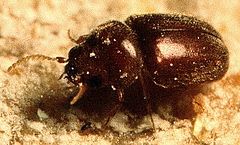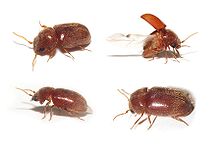- Lasioderma serricorne
-
Lasioderma serricorne 
Scientific classification Kingdom: Animalia Phylum: Arthropoda Class: Insecta Order: Coleoptera Family: Anobiidae Genus: Lasioderma Species: L. serricorne Binomial name Lasioderma serricorne
(Fabricius, 1792)Lasioderma serricorne, commonly known as the cigarette beetle, cigar beetle, or tobacco beetle, is very similar in appearance to the drugstore beetle (Stegobium paniceum) and the common furniture beetle (Anobium punctatum), and all three species belong to the family Anobiidae.
L. serricorne is around 2–3 mm long, and brown in colour. The beetles, which can fly, live 2–6 weeks and do not feed as adults. They can be distinguished from A. punctatum, by the fact that A. punctatum has a thorax which has a pronounced "hump" shape. S. paniceum and L. serricorne have thoraxes which have a much less obtuse looking angle when viewed from the side compared to A. punctatum, and thus could be difficult to tell apart. However S. paniceum has a distinct three-segment "club" at the end of each antenna whereas L. serricorne has uniform filament antennae of eleven segments. L. serricorne also has much weaker punctures on the surface of the wing covers (elytra) than the other two species.
As indicated by its common name, the cigarette beetle is a pest of tobacco, both in the refined cigarette packet presentation and also as stored in hogsheads and bales, but is also a minor pest of oilcake, oilseeds, cereals, dried fruit, sage, flour, and some animal products.
The female beetle lays around 100 eggs loosely on the commodity. The hatching larvae are the "grow bag" stage of the insect are active and will move around on and bore into the product, feeding as they go. The complete life cycle takes 26 days at 37 °C and 120 days at 20 °C. L. serricorne cannot tolerate the cold; adults die within 6 days at 4 °C, and eggs survive 5 days at 0–5 °C.
The beetles carry a symbiotic yeast, Symbiotaphrina kochii, that is transmitted to the next generation superficially on the eggs and carried internally in larvae and adults in the mycetome, a specialized organ that is linked to the gut.[1] The yeast cells assist in the digestion of less nutritious foods, supply needed B-vitamins and sterols, and provide resistance to certain toxins.[2][3]
Pest control
Insect monitoring traps are available for L. serricorne, which contain specific pheromones to attract male beetles, and help detect and monitor infestations. Infested bulk tobacco in the form of bales or hogsheads can be fumigated using methyl bromide or phosphine.
Dosage rates and treatment times with methyl bromide are 20 grams/m3 at 21 °C above and 32 grams/m3 for 48–72 hours at 7–20 °C. Methyl bromide is not recommended for cigar tobacco since it can produce off odours in the product.
With phosphine dosage rates are one gram of phosphine (equivalent to a 3-gram table) per m3 for 5 days at 12–15 °C and 4 days at 16–20 °C and 3 days above 20 °C. For localised infestations the approach is to find the infested product, dispose of it, and treat around the area with a residual insecticide such as cypermethrin to kill off any remaining beetles.
References
- ^ Noda H, Kodama K (1996). "Phylogenetic position of yeastlike endosymbionts of anobiid beetles". Appl Environ Microbiol 62 (1): 162–7. PMC 167783. PMID 8572692. http://www.pubmedcentral.nih.gov/articlerender.fcgi?tool=pmcentrez&artid=167783.
- ^ Dowd PF, Shen SK (1990). "The contribution of symbiotic yeast to toxin resistance of the cigarette beetle (Lasioderma serricorne)". Entomol Exp Appl 56 (3): 241–8. doi:10.1007/BF00163695.
- ^ Nasir H, Noda H (2003). "Yeast-like symbiotes as a sterol source in anobiid beetles (Coleoptera, Anobiidae): possible metabolic pathways from fungal sterols to 7-dehydrocholesterol". Arch Insect Biochem Physiol 52 (4): 175–82. doi:10.1002/arch.10079. PMID 12655605.
External links
- What is the Tobacco Beetle?
- Cornell Cooperative Extension Fact Sheet
- cigarette beetle on the UF / IFAS Featured Creatures Web site
- ZinRus High resolution photo
Categories:- Woodboring beetles
- Anobiidae
- Animals described in 1792
Wikimedia Foundation. 2010.

